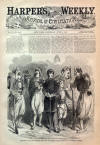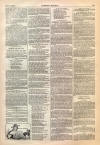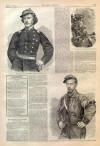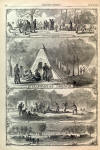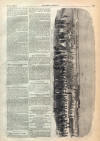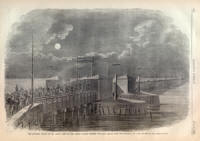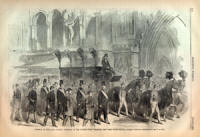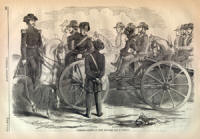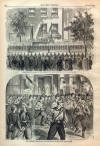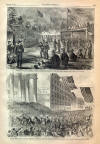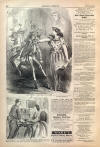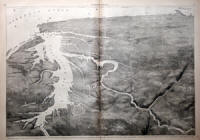|
This Site:
Civil War
Civil War Overview
Civil War 1861
Civil War 1862
Civil War 1863
Civil War 1864
Civil War 1865
Civil War Battles
Confederate Generals
Union Generals
Confederate History
Robert E. Lee
Civil War Medicine
Lincoln Assassination
Slavery
Site Search
Civil War Links
Civil War Art
Revolutionary War
Mexican War
Republic of Texas
Indians
Winslow Homer
Thomas Nast
Mathew Brady
Western Art
Civil War Gifts
Robert E. Lee Portrait
|
OUR MAP OF THE SEAT OF WAR.
ON
pages 360 and 361 we publish a
large BIRDS-EYE VIEW OF THE SEAT OF WAR IN VIRGINIA and the neighborhood, which
will enable our readers to follow the march of the armies intelligently. We
subjoin a few memoranda of some of the principal points in Virginia:
The city of
Norfolk is on the right bank of Elizabeth
River, just below the confluence of its two branches, eight miles from Hampton
Roads, and thirty-two miles from the ocean. It contains a
United States Navy-yard, in which is a
dry-dock, constructed of hewn granite, which cost $974,436. The Dismal Swamp
Canal connects Chesapeake Bay with Albemarle Sound, and opens an extensive water
communication with Norfolk to the South. The population of the city is about
20,000.
Lynchburg is situated 116 miles
west of Richmond and 191 from Washington, on the south bank of James River, at
the junction of the Petersburg and Lynchburg Railroad with the Virginia and
Tennessee Railroad. It has a variety of manufacturing establishments, such as
cotton and tobacco factories, and an iron thundery. The city enjoys many natural
advantages for military defense, and the climate is quite healthy. At present a
military column of rebels is concentrated at this point, awaiting orders from
head-quarters. Some accounts say there are fully 25,000 men at that point.
Fredericksburg is situated on the
right bank of the Rappahannock River, at the head of tide water, one hundred and
ten miles above the Chesapeake, and on the Richmond, Fredericksburg, and Potomac
Railroad, sixty miles from the former place, and seventy miles from Washington.
The population of the city is between six and eight thousand. Fredericksburg
enjoys good natural facilities for military defense, from its contiguity to the
Potomac, and is now being used as the concentrating point for a large body of
rebel troops. It is on a line of railroad leading to Washington. Fredericksburg,
Richmond, Lynchburg, and Petersburg compose a quadrilateral of no mean military
significance; its importance has already been appreciated by the rebel chiefs.
Petersburg is a port of entry, on
the south bank of the Appomattox River, twelve miles above its entrance into
James River, at City Point. The city contains about 18,000 inhabitants. It has
good railroad facilities to Washington, which is 140 miles distant.
Yorktown is a port of entry, 185
miles from Richmond. It is a small village, and memorable as the place where
Lord Cornwallis surrendered the British army to General Washington, October 19,
1781, which event terminated the Revolutionary War. It derives importance at the
present time from the fact that the Southern rebel forces are establishing a
camp there, apparently to counter any land movement of United States troops from
Fortress Monroe, which is seventeen and a half
miles distant. It is not unlikely that, from present appearances, a second
battle of Yorktown may be fought.
Winchester is the capital of
Frederick County, Virginia. It is 150 miles north-northwest of Richmond, and 71
miles west by north of Washington. It is the terminus of the Winchester and
Potomac Railroad, thirty miles long, connecting with the Baltimore and Ohio
Railroad at
Harper's Ferry, and it has a number of turnpike
roads radiating in all directions, which attract a large amount of trade and
travel. Population in 1850, 4500.
GEN. CADWALLADER'S CAMP
AT BALTIMORE.
WE publish herewith a picture,
from a photograph by Weaver, of GENERAL. CADWALLADER'S CAMP of Federal troops at
Locust Point, opposite Baltimore city. A correspondent of the Tribune thus
described it when it was first established:
"This encampment, which may very
appropriately be called Camp Cadwallader, is only temporary. It does well in dry
weather, but is too low when it rains. Thousands of people visited the spot
today, and the rickety old ferry-boat from the foot of
Broadway on Fell's Point
to Locust Point groaned beneath its astonished load of visitors. There are sixty
rows of tents in the encampment, numbering some 500 in all. The men all bathed
this morning by companies in the basin, at a proper distance from the crowds.
Last night they went through regimental drill, to the great delight of the
by-standers. The, officers of the regiments have their quarters in a fine brick
house called the Vineyard, in close proximity to the camp. General Cadwallader's
head-quarters are in an outhouse within the fort grounds, but will be removed
to-morrow to the Hospital, just within the outer gate."
THE ADVANCE INTO VIRGINIA.
SHORTLY after midnight, on the
morning of March 24, the " Advance Guard of the great Army of the United States"
entered the State of Virginia opposite Washington, crossing by the
Long Bridge at
Alexandria, and the Iron Bridge at
Georgetown. We publish on
page 356,
from a drawing by our special artist, an engraving of the
ARMY CROSSING THE LONG
BRIDGE. The following description of the scene is from the Herald :
"The order to march for Virginia
at two o'clock this morning was communicated to the officers of the different
regiments at the evening parades, but it was kept from the men until shortly
before midnight, when it was generally promulgated. It was received by the
various corps with true martial enthusiasm. The men having been kept in
readiness since the night before last, the final packing up did not require much
time. At midnight all were ready to move. The Fifth and Twenty-eighth New York
regiments, having the longest distance to march to the rendezvous from the
Capitol to Georgetown, commenced moving at half-past twelve. They came down the
avenue with, as heretofore, soul-stirring, far-sounding martial strains, but
with quiet tread, more like that of hundreds than thousands of men. Soon after
they had passed, the New Jersey brigade, the Michigan regiment, and the Twelfth
and Seventh of New York, crossed the avenue with equal quietness. So little
noise did they cause that hardly any of the denizens of Washington were awakened
from their peaceful slumbers.
"The scene at the bridges was
grand and impressive beyond description, and one that the writer will ever
remember. The night was cool and clear, thousands of men were drawn up in line
and defiling past, but hardly a whisper was heard from among them. They all
preserved a solemn silence, as though sensible of the momentousness of the
occasion; but the rumbling of artillery, the clatter of cavalry, the muskets and
ordnance glittering in the moonlight, the suppressed commands of the officers,
imparted, nevertheless, a liveliness to the imposing spectacle.
"The troops took rations for only
two days along, but large quantities of provisions will be conveyed across the
river to-day. All the troops carried their knapsacks, blankets, canteens, etc.,
with the exception of the Seventh, which went without knapsacks. From this it
was inferred that the latter corps would make but a short stay on the right bank
of the Potomac.
" The main body of the troops
were all across the two bridges in two hours after they commenced entering upon
them. Three or four companies marched over at a time, in broken steps."
THE GARIBALDI GUARD.
WE publish on
page 362 a picture
of the GARIBALDI GUARD in the street, marching in double-quick time and another
of the presentation of colors to
them, which took place last week.
They are a very gallant regiment, consisting chiefly of Italians, Hungarians,
and Germans. The following description of the presentation of colors appeared in
the Herald:
" The first flag presented was
from Mrs. A. H. Stephens. It is a beautiful silken American standard. The
borders are delicately ornamented with gold tassels and fringe, elaborately
worked. A golden eagle sits proudly on the top of the staff. The centre of the
flag is inscribed ' Garibaldi Guard,' in plain gilt letters ; and beneath this
are the words, ' Presented by Mrs. A. H. Stephens, May 23,1861.'
"A speech was made, to which
Colonel Utassy responded in appropriate terms, and the flag was passed into the
custody of the standard-bearer.
" The next flag presented was a
rich Hungarian standard—green, red, and white stripes. On one side was the
motto, within a wreath, ' Vivecere aut morire;' and on the opposite side, in
English, the same motto, 'Conquer or die.' The regimental name appeared on each
side, over and underneath the wreaths, in English. This elegant present was from
Miss Grinnell. It had four beautiful silk pendants of colors and inscriptions,
the latter embroidered, as follows : White, "Sylvia Grinnell ;' red, ' Presented
to the Garibaldi Guard ;' blue, 'New York, 23d May, 1861;' red, white, and blue,
' Brethren before, brethren again.'
" The next flag attracted much
attention from the fact that it is surrounded by Revolutionary and sanguinary
memories. This was the tricolor standard which the patriot Garibaldi bore in
triumph through the campaign of 1848 and 1849, and with his own hand planted on
the battlements of one of the castles of the Eternal City—a triumphant emblem of
liberty and power. The flag is composed of the Italian colors—green, red, and
white—and is inscribed in Italian in the centre, ' Dio E Popoli'—God and the
People.
" In presenting the flag to the
regiment, Lieutenant Colonel Repetti came to the front, leading by the hand a
very beautiful young lady, the daughter of General Avezzana, and addressed the
regiment in the Italian language. He, in substance, said:
" OFFICERS AND SOLDIERS OF THE
GARIBALDI GUARD,
It is with very great pleasure
that I accept the duty of presenting to you this memorable flag—a flag which
Garibaldi himself has consecrated to the cause of liberty. It is the gift to the
regiment of this young lady, the daughter of one of the most intimate friends of
our beloved General. Let the gift be dear to every one of you, and as, wherever
danger is thickest, this flag shall wave, there shall be your place to defend
it. Soldiers of the Garibaldi Guard—Hungarians, Germans, Italians, Frenchmen,
Spaniards, and men of every other nationality—take this honored flag and swear
to defend it through every peril. Swear!' [Loud cries of ' We swear!']
"Loud applause followed, the band
playing the 'Marseillaise' as the flag was given over to the regiment."
WE publish on
page 363, from a
sketch kindly sent us by Mr. Noble, a picture of the Guthrie Gray Regiment,
Colonel Bosley commanding, passing through Cincinnati on the morning of May 17,
1861. They left Camp Harrison that morning, and took the cars, after passing
through the city, for Camp Dennison. The Cincinnati Times said of them :
" Every house had a welcome for
them, and large numbers of friends, in carriages and on horseback, escorted
then. The regiment was followed by a crowd, which kept constantly increasing. At
Ninth Street Menter's band, which marched at the head of the regiment, struck up
a lively air, and the spectators were soon multiplied by thousands. Some three
or four of the companies were in the new uniform. The rest wore loose gray
overshirts, and while they did not look quite so soldierly as the rest, were in
better trim to stand the fatigue, and indeed made the better appearance. Company
D, thus attired, was highly commended by the spectators. The buildings on either
side of Fourth Street and the sidewalks were crowded with people, including a
great many ladies, who greeted the Grays with the waving of handkerchiefs, hats,
and flags, clapping of hands, and cheers. The Post-office corner sent up a
rousing cheer. The brave fellows seemed to forget in a moment the fatigues of
their march, amidst this splendid demonstration of the people."
THE EXCELSIOR BRIGADE.
WE publish on
page 363 a picture
of the BIVOUAC OF THE EXCELSIOR BRIGADE at the Red House, Harlem. This is
General Sickles's brigade, which has been recruited at 444 Broadway, and is said
to be destined for active service at the South. They are a fine body of men, and
will doubtless give a good account of themselves.
THE FUNERAL OF COLONEL
VOSBURGH.
ON
page 364 we publish a picture
of the FUNERAL CEREMONIES OF COLONEL VOSBURGH, late Commander of the 71st
Regiment, N. Y. S. M. Colonel Vosburgh died of hemorrhage of the lungs at
Washington last week, and was buried here on 23d instant. The military programme
was observed throughout as arranged by the Committee having the matter in
charge, in the following order :
First Regiment of Cavalry,
Lieut.-Col. T. C. Devin. Third Regiment of Cavalry, Lieut.-Col. Menck.
Seventy-ninth Regiment, Lieut.-Col. Elliott commanding. Eleventh Regiment of
Rifles, Col. J. Maidhof. Detachment of the Ninth Regiment, Major E. L. Stone.
Fifty-fifth Regiment, Guard of Honor, Col. Eugene Le Gal. First Regiment N. Y.
S., Col. Wm. H. Allen. Officers of the First Division not on duty. Officers of
the Volunteer Regiments in the city and vicinity.
Clergy and Physicians.
Pall-bearers. Military
Escort. THE HEARSE. Military Escort. Horse of the deceased. Immediate
relatives of the deceased. Members and ex-members of the Seventy-first in
citizens' dress, as mourners. Sergeant-at-arms of the Common Council.
Joint Committee of the Common Council.
Mayors of New York, Brooklyn, and Jersey City. Heads of Departments, and
Common Council of New York, with their staffs of office. Union Defense
Committee.
Tammany Society, of which deceased was a member. Metropolitan Home Guard.
Civic Societies. Citizens generally.
The following gentlemen, from
military and civil life, acted as pall-bearers, according to the pro-gramme :
Military — Gen. Hall, Gen.
Storms, Gen. Spicer, Gen. Yates, Gen. C. H. Arthur, Col. Postley, Col. Hincken,
Col. Styles, Col. Van Buren, Col. Pierson, Lieut.-Col., Osgood, Lieut.-Col.
Halleck. Civil—Emanuel D. Hart, George W. M'Lean, Simeon Draper, Isaac Bell,
Jun., John Van Buren, John R. Carland, David H. Turner, Edward Vincent, Richard
Winne, John S. Lawrence, Halsey Mitchell, John R. Briggs.
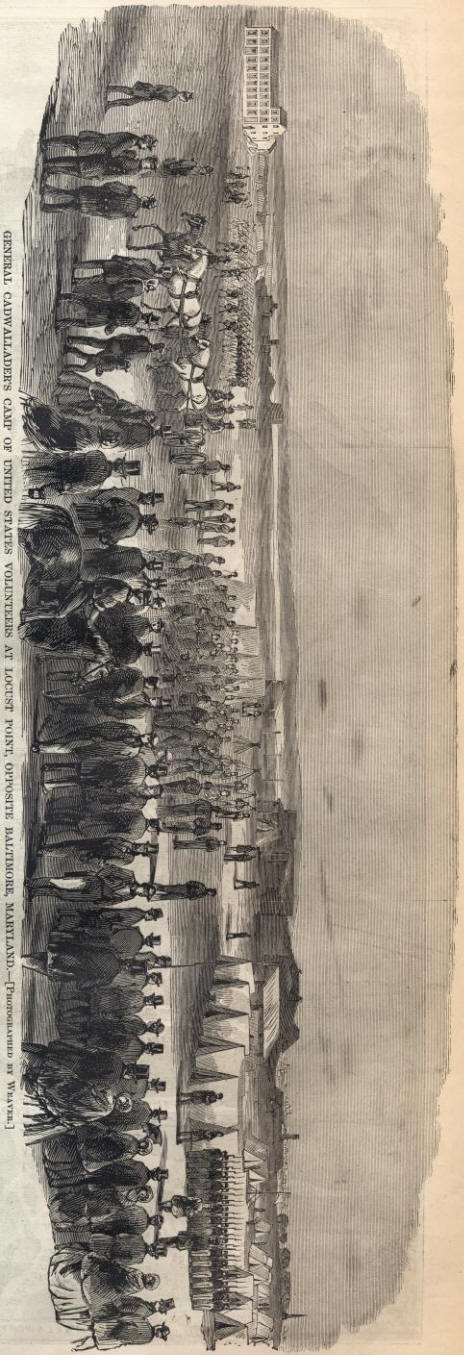
|
